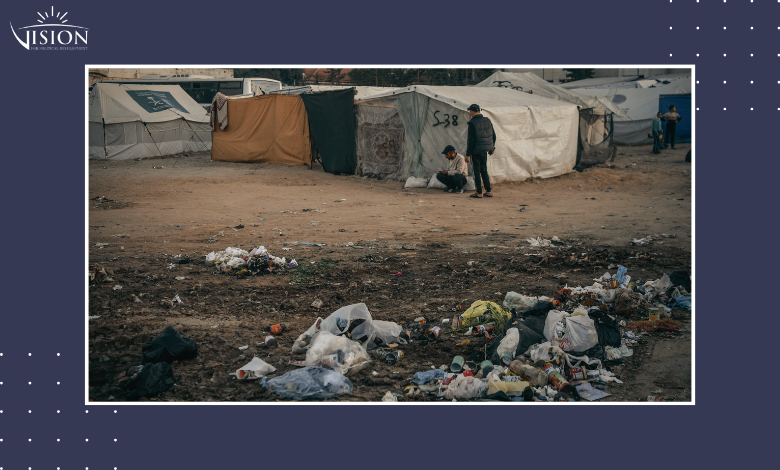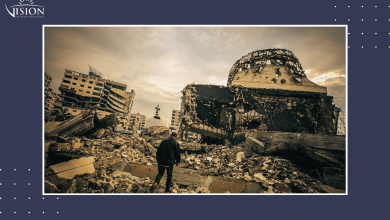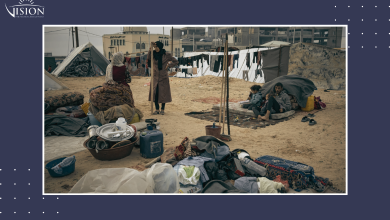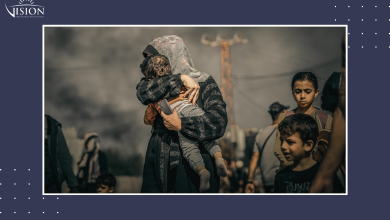The Water, Sanitation, and Hygiene Crisis in Gaza

The Israeli occupation army has forced more than 90% of Gaza’s population, whose numbers have dropped to 2.13 million during the genocide; to flee their homes due to the policy of internal forced displacement imposed since the genocidal onslaught on October 7, 2023. With around 92% of Gaza’s housing units destroyed by the occupation, the displaced were compelled to take shelter in temporary facilities such as schools, hospitals, and public buildings, until these became overcrowded, forcing many to pitch tents in public squares and along sidewalks, “fleeing from a quick death to a slow one.”
The displacement camps lack even the most basic necessities of human life, particularly since more than 77% of Gaza’s water, sanitation, and hygiene (WASH) assets and facilities are currently located within the military zone under Israeli control. This creates conditions for the spread of waterborne and sanitation-related diseases. According to assessments conducted by the WASH Cluster in Gaza, about 96% of households are suffering from moderate to severe water insecurity, while 78% face barriers in accessing toilets or sanitation facilities, which are essential for preserving human dignity and public health.
Displaced persons in the Gaza Strip live in difficult conditions, despite the provisions of international agreements regarding the protection of civilians. The Second Additional Protocol to the Geneva Conventions stipulates that all possible measures must be taken to accomodate civilian populations in satisfactory conditions in terms of shelter, preventive and curative health care, safety and nutrition. International humanitarian law also urges the provision of adequate housing, especially for women and their families, to ensure their health and dignity, as well as protection and safe access to health facilities[1].
First: The Current Situation of Water, Sanitation, and Hygiene (WASH)
Palestinian refugees in the Gaza Strip are experiencing a severe health and humanitarian crisis linked to the lack of adequate sanitation facilities, following the complete destruction of residential buildings and infrastructure by the Israeli occupation army, in addition to their insufficient numbers for the thousands of refugees in shelters and temporary refugee camps.
The shortage of toilets and sanitation facilities is one of the biggest humanitarian challenges facing displaced persons. In shelters such as schools and public and private centers and institutions, thousands of people share a small number of bathrooms, and in some cases only one bathroom. In informal camps set up in public spaces, open land, sidewalks, and islands on main and side streets, primitive bathrooms have been constructed, surrounded by metal sheets or worn fabric with a small hole in the middle, or plastic containers are used inside tents due to the lack of space to build a bathroom next to them.
The crisis of displaced persons is exacerbated by the lack of drinking water or water for daily use, which affects personal hygiene and increases the likelihood of disease. In addition, the lack of maintenance and cleanliness of existing bathrooms exacerbates the suffering of refugees. Power cuts and water shortages lead to the accumulation of human waste in bathrooms, and consequently the spread of foul odours and disease-carrying insects. This creates a fertile environment for the spread of epidemics and infectious diseases, including gastrointestinal diseases such as diarrhoea, cholera, and typhoid, and viral infections such as hepatitis A and E. Polio virus also spreads through contact with faeces or through oral transmission by swallowing contaminated food or water.
In a World Health Organization report on infectious diseases prevalent among displaced persons, the lack of clean toilets was one of the main causes of the spread of disease, with 103,000 cases of scabies and lice, more than 65,000 cases of skin rashes, and about 11,000 cases of chickenpox documented.
There were also 107,000 cases of hepatitis A or jaundice, about 577,000 cases of acute watery diarrhoea, and 12,000 cases of bloody diarrhoea among displaced persons in the Gaza Strip as of July 29, 2024. The polio virus was also detected in sewage samples in Khan Yunis and Deir al-Balah, and three cases of paralysis were reported among children who had not been vaccinated. The organization notes that vaccination rates in Gaza have fallen from 99% to 86% since the outbreak of the war.
While numerous humanitarian organizations attempted to bring portable toilets to the camps, they were met with refusal. UNICEF and the Palestinian Red Crescent Society announced that they had attempted to bring portable toilets and materials to build sanitation facilities, but the occupation forces prevented them from doing so. Abrasak Kamara, UNICEF’s director of water and sanitation in Palestine, considered the lack of sanitation services “a source of public health concern and a way of stripping people of their dignity.”
The Israeli occupation does not stop there, but deliberately targets some shelters even after they have been equipped with temporary sanitation facilities, so that the displaced remain in constant suffering and instability. The latest example of this was the bombing of the Al-Mansara camp for displaced persons in Deir Al-Balah, which contains 200 tents equipped with temporary sanitation facilities.
Second: Lack of Privacy in Sanitary Facilities
Another serious humanitarian challenge facing displaced persons in Gaza is the lack of privacy in sanitary facilities, especially for girls, women, and children, who live in difficult conditions in plastic and canvas tents crowded together side by side. The situation is exacerbated when displaced persons set up their tents on sidewalks or in the middle of streets, where there are no equipped bathrooms or secure toilets.
Refugees are forced to walk long distances to use a single bathroom once a day, only to face hours of waiting in front of strangers to enter a shared bathroom that lacks the most basic hygiene conditions. In this context, Malak, a girl who was displaced with her family to a shelter west of Gaza City, says: “Displaced men and women line up in a single queue for a single bathroom in a center that houses nearly a thousand displaced people, with the queue stretching for several meters. This has led me to refrain from using the bathroom by reducing my food and drink intake and postponing going to the bathroom for long hours, which has resulted in severe kidney pain[2],” while another woman’s abstinence from using the bathroom for long hours led to painful physical complications, ending in surgery for haemorrhoids[3].
What makes things even more difficult for displaced persons is the lack of sanitary facilities equipped to ensure their privacy and safety, such as secure doors, which can put them in extremely embarrassing and humiliating situations, as happened to a displaced woman in one of the shelters.
She says: “I was in the bathroom doing my business when someone opened the door on me. I came out crying from the horror of what had happened to me.” She added “In another situation, I found myself breaking into the bathroom door and someone was inside, so I felt myself shrink with embarrassment and shame, and wished the ground would swallow me up rather than be in this situation, which affected me and put me in a state of fear and terror that it would happen again.”
The suffering becomes even more difficult and complicated if one of the displaced persons is physically injured unable to move or sit properly, rendering them incapable of caring for themselves and forcing them to rely on others even to relieve themselves.
This is the case with Nour, a girl who lives in a small tent with her family of ten on an island in one of the streets of Gaza City. She says: “My dignity has been violated, my privacy has been destroyed, I am no longer able to do anything. I came out from under the concrete rubble to find myself under immense psychological pain. My mother brings me a piece of plastic to relieve myself, then she picks it up and cleans it so I can reuse it when needed.”
Women face difficulties with personal hygiene, especially during their menstrual cycle. “I feel embarrassed that my family members know about this, but today, due to the primitive toilet that was built next to the tent and its foul smell full of filth, unfortunately, I have to do it inside the tent until the day of bathing and purification, which is rushed, so that my children do not have to wait for me for long in the street. There is no other place to bathe except in the tent.”[4]
Like adults, young children lack basic hygiene due to the lack of toilets suitable for their age, exposing them to frequent infections, severe diarrhoea, and skin diseases such as allergies and scabies. Um Muhammad Ghabn says: “My little boy got severe diarrhoea, while my daughter Nour got scabies because there is no clean toilet, water is scarce, and cleaning supplies are non-existent.”[5]
Third: Psychological and social dimensions
The sanitation crisis in the Gaza Strip is not limited to service or health aspects; it goes much deeper than that. The deprivation of clean and safe bathrooms has psychological and social consequences for displaced persons, who suffer from a constant feeling of humiliation and violation of their human dignity.
Psychologist and social worker Sabreen Al-Shaer[6] believes that the lack of safe and private bathrooms leads to a deep sense of humiliation and lack of privacy, causing people to lose their sense of basic humanity, especially women who suffer from constant anxiety about relieving themselves, day and night, during childbirth and menstruation, as well as the lack of lighting and safety when accessing public bathrooms at night. All of this creates a state of tension, fear, and terror, as well as nighttime anxiety attacks and sleep disturbances.
With the absence of the most basic necessities for a decent life, such as a bathroom, daily life becomes a series of psychological humiliations that leave long-term effects, such as depression and a loss of self-control. A woman who was displaced from her home in Beit Lahia says, “I started having severe anger attacks as a result of the situation I am living in, a small tent on the sidewalk, next to a primitive bathroom consisting of a small hole surrounded by two pieces of cloth, from which foul odours emanate, attracting flies to the place. You have to relieve yourself in a hurry, with your family waiting in line behind you, so you don’t feel comfortable even when defecating.”[7]
Conclusion
The sanitation crisis under the ongoing genocide in Gaza represents not only a humanitarian and health emergency but also an affront to human dignity, threatening the lives of more than two million displaced persons and raising the risk of widespread disease and epidemics, further compounding the catastrophic situation of Palestinians in Gaza.
The persistence of this crisis deepens the psychological suffering of Gazans and casts a heavy shadow over community life, particularly due to the lack of privacy for women, who have been forced to use shared or makeshift toilets that lack even the most basic standards of human privacy.
This is where the role of international organizations and institutions becomes crucial in pressuring the Israeli occupation army to urgently allow the entry of mobile toilets and sanitation facilities into shelters and camps, in addition to protecting existing facilities from targeting, while also launching health awareness campaigns for the displaced on ways to prevent diseases under such dire health conditions.
[1] Charlotte Linds, Women in Conflict, 3rd edition, International Committee of the Red Cross, 2009, p. 118.
[2] Interview conducted by the researcher with a woman who fled from the Al-Zaytoun neighborhood to the Al-Rimal area west of Gaza, on August 24, 2025.
[3] Interview conducted by the researcher with a woman who fled from Beit Lahia to the Rimal area west of Gaza, on August 24, 2025.
[4] Interview conducted by the researcher with a woman who fled from Jabalia to the Ramal area west of Gaza, on August 24, 2025.
[5] Interview conducted by the researcher with a woman who fled from Beit Lahia to the Rimal area west of Gaza, on August 24, 2025.
[6] Interview conducted by the researcher with psychologist and social worker Sabreen Al-Shaer on August 27, 2025.
[7] Interview conducted by the researcher with psychologist and social worker Sabreen Al-Shaer on August 27, 2025.
NOTE: This text is adabted from original Arabic article.





